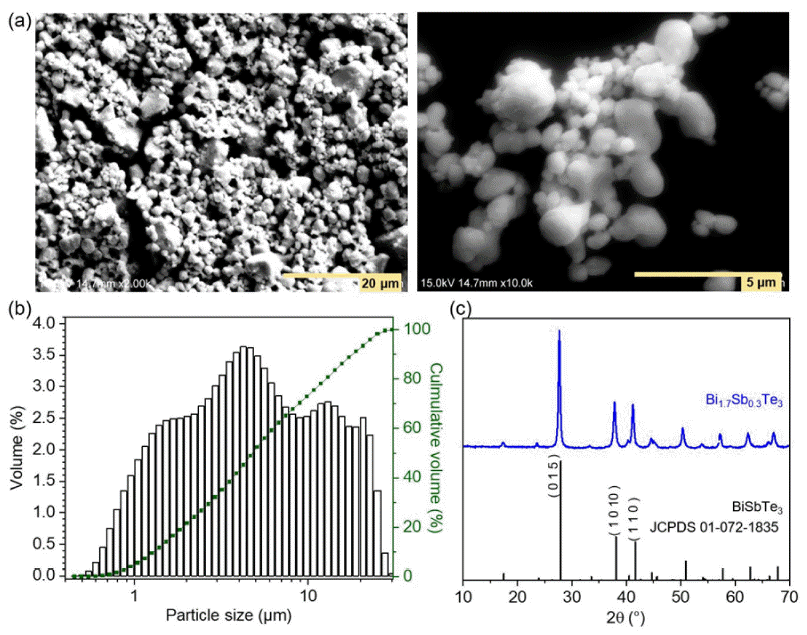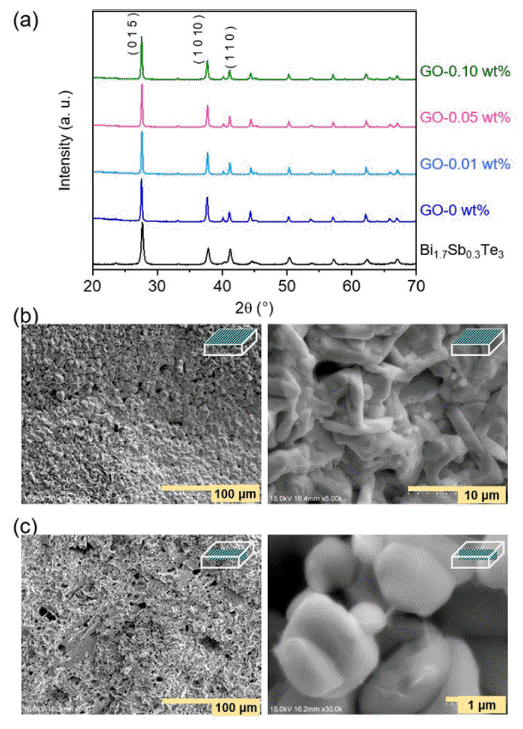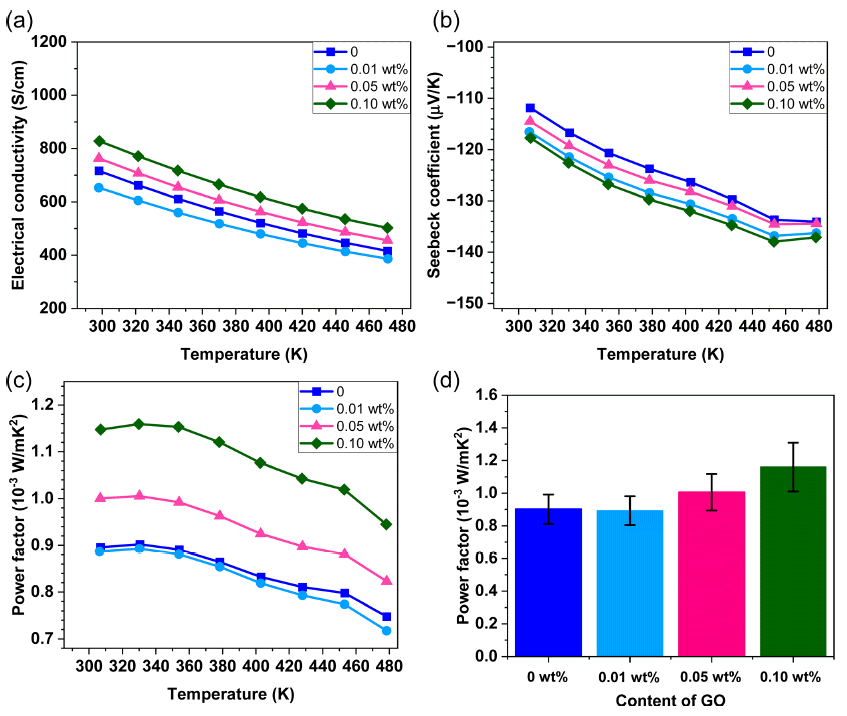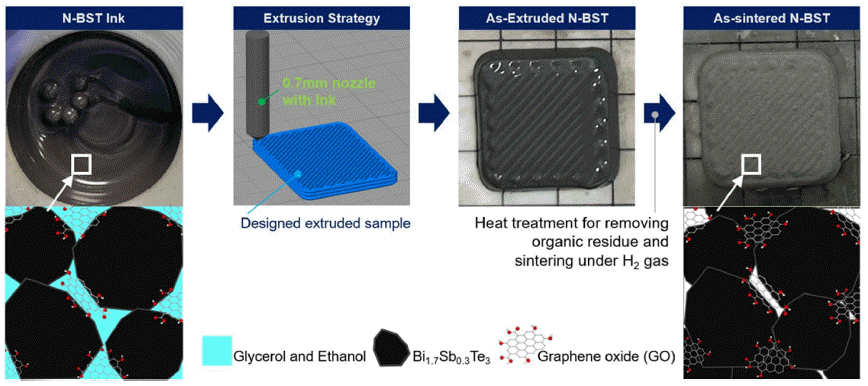Articles
- Page Path
- HOME > J Powder Mater > Volume 30(4); 2023 > Article
-
Article
- Enhancing Electrical Properties of N-type Bismuth Telluride Alloys through Graphene Oxide Incorporation in Extrusion 3D Printing
- Jinhee Bae, Seungki Jo, Kyung Tae Kim*
-
Journal of Korean Powder Metallurgy Institute 2023;30(4):318-323.
DOI: https://doi.org/10.4150/KPMI.2023.30.4.318
Published online: July 31, 2023
Department of 3D Printing Materials, Powder Materials Division, Korea Institute of Materials Science (KIMS), Changwon 51508, Republic of Korea
- * Corresponding Author: Kyung Tae Kim, TEL: +82-55-280-3506, FAX: +82-55-280-3474, E-mail: ktkim@kims.re.kr
- - J. Bae·S. Jo: 선임연구원, K. T. Kim: 책임연구원
• Received: June 16, 2023 • Revised: July 7, 2023 • Accepted: July 8, 2023
© The Korean Powder Metallurgy Institute. All rights reserved.
- 557 Views
- 7 Download
- 1 Crossref
Abstract
- The thermoelectric effect, which converts waste heat into electricity, holds promise as a renewable energy technology. Recently, bismuth telluride (Bi2Te3)-based alloys are being recognized as important materials for practical applications in the temperature range from room temperature to 500 K. However, conventional sintering processes impose limitations on shape-changeable and tailorable Bi2Te3 materials. To overcome these issues, three-dimensional (3D) printing (additive manufacturing) is being adopted. Although some research results have been reported, relatively few studies on 3D printed thermoelectric materials are being carried out. In this study, we utilize extrusion 3D printing to manufacture n-type Bi1.7Sb0.3Te3 (N-BST). The ink is produced without using organic binders, which could negatively influence its thermoelectric properties. Furthermore, we introduce graphene oxide (GO) at the crystal interface to enhance the electrical properties. The formed N-BST composites exhibit significantly improved electrical conductivity and a higher Seebeck coefficient as the GO content increases. Therefore, we propose that the combination of the extrusion 3D printing process (Direct Ink Writing, DIW) and the incorporation of GO into N-BST offers a convenient and effective approach for achieving higher thermoelectric efficiency.
- The rapid increase in energy consumption since the industrial revolution has led to the depletion of fossil fuels and serious environmental problems including global climate change. In relation to efforts to address these issues, there is a growing global demand for renewable energy.
- The phenomenon of thermoelectrics, materials that can convert thermal energy into electrical energy or vice versa, is attracting attention as an environmentally friendly renewable energy technology that generates electricity from industrial waste heat. The conversion efficiency of a thermoelectric material is determined by its dimensionless merit figure, zT = α2 σT/κ, where α, σ, and κ are the Seebeck coefficient, electrical conductivity, and thermal conductivity, respectively. To maximize the zT, a high Seebeck coefficient, high electrical conductivity, and low thermal conductivity are required; these factors are closely related to the charge concentration and cannot be controlled independently. In light of this, many studies have been carried out to improve the electrical properties or to control the thermal properties [1-6]. Conventional thermoelectric materials have been fabricated through processes such as zone melting, melt spinning, cold or hot pressing, and spark plasma sintering to achieve uniform and high performance [7-14]. The obtained bulk materials typically require cost inefficient and time consuming cutting processes for performance evaluation and device fabrication. Additionally, bulk materials have limited shapes and sizes, and thus large and complex shapes of thermal materials cannot be obtained. In recent years, 3D printing technologies (additive manufacturing) have been introduced to thermoelectric materials in order to print complex shapes with efficient processes and to prevent material loss [15-20]. In the case of thermoelectric materials, Direct Ink Writing (DIW) is known to be the most suitable process among 3D printing process technologies, as the alloy composition is not maintained due to the volatilization of Bi and Te elements when using highenergy heat sources such as lasers. The DIW process has the advantages of being fast, customizable, and costeffective for large-scale industrial applications. However, the polymeric organic binders used for viscoelastic inks in this process can act as organic impurities or form pores during the degassing and sintering processes. This in turn leads to significant degradation of electrical properties such as electrical conductivity, which is a key part of the performance of a thermoelectric material.
- To address this issue, research has been carried out to reduce organic binders to very low levels or to use inorganic binders to simultaneously increase the density and thermoelectric performance of DIW samples [21-23]. In addition, edge-oxidized graphene (EOG) has been introduced to create new charge transport pathways by locating graphene materials in the pores and to compensate for the shortcomings of ink-based thermoelectric materials [24,25].
- In this study, we performed the DIW process using ntype alloyed Bi1.7Sb0.3Te3 (N-BST) based ink which was suitable for extrusion and shape maintenance without any organic binder. By selecting an Sb-based material instead of an Se-based material for the n-type, the composition of which can be easily changed due to its low vaporization energy, the stability of the composition was ensured even with longer heat treatment compared to spark plasma sintering.
- Oxidized graphene oxide (GO), which has excellent electrical properties, was introduced into the ink to address the problem of poor electrical conductivity. Glycerol, which has high viscosity that allows the shape of extruded composition to be maintained, was used as the base solvent, and a small amount of low-boiling point ethanol was added to disperse the GO and uniformly mix the powder and glycerol. A suitable extrusion-based 3D printing process was found for the fabrication of thermoelectric materials, and the electrical conductivity and Seebeck coefficient were confirmed according to the amount of GO added to the ink.
1. Introduction
- 2.1 Synthesis of n-type Bi1.7Sb0.3Te3 and ink for 3D printing sample
- To obtain the alloyed powder of Bi1.7Sb0.3Te3, stoichiometric shot materials of Bi, Sb, and Te (from Taewon Science) and ZrO2 balls with twice the weight of the shot materials were placed in a ZrO2 container. High-energy ball milling was then carried out for 12 hours at 380 rpm (Fritsch Planetary Milling Machine).
- The graphene paste (MExplorer) was dried at low temperature to obtain dried graphene powder for fine control of graphene oxide (GO). For uniform dispersion of GO in the ink, GO corresponding to 0, 0.01, 0.05, and 0.10 wt% of the powder was added to 0.4 g of ethanol and sonicated for more than 30 min. In a container, 10 g of Bi1.7Sb0.3Te3 powder, 1.25 g of glycerol, and ethanol with dispersed graphene oxide were uniformly mixed three times for 5 minutes each time using a blender. The resulting ink was transferred to a syringe and extruded, and the sample was simultaneously dried and sintered in a tube furnace in an H2 atmosphere. Due to the high boiling point of glycerol, the extruded samples were dried at 250°C for six hours and immediately sintered at 500°C. The hydrogen atmosphere is essential as the degree of oxidation of the powder has a significant effect on sinterability.
- 2.2 Characteristics of the powder and samples
- The Bi1.7Sb0.3Te3 powders and sintered samples were characterized by X-ray diffraction (D/MAX 2500V/PC, Rigaku) and scanning electron microscopy (SU-6600, HITACHI) to confirm their crystalline phase and microstructure. The particle size distribution of the powders was also measured using a laser particle size analyzer (PSA, FPAR-1000, Formulaction, France). The electrical conductivity and Seebeck coefficient of the samples were measured every 25 K in the range of 473 K at room temperature (SBA 458 Nemesis, NETZSCH).
2. Experimental
- After alloying, the Bi1.7Sb0.3Te3 (N-BST) powder was examined using SEM imaging and particle size analysis, as shown in Figure 1. The results revealed that over 70% of the powder had a size of 10 μm or smaller. X-ray diffraction patterns confirmed the formation of a phase identical to the alloy with BiSbTe3 composition, and no presence of other impurities or unreacted raw materials was observed.
- The Direct Ink Writing (DIW) 3D printing process is illustrated in Figure 2. A sample with dimensions of 1.2 × 1.2 × 1.8 mm was prepared by extruding N-BST ink through a 0.7 mm needle. As evident from the photograph, the three-dimensional shape is well-preserved even after extrusion and sintering. During this process, it was expected that GO would not be removed but rather combined with N-BST to hinder crystal growth and form a new interface by connecting crystals near the pores. The samples were then prepared by adjusting the amount of GO to the N-BST powder mass, resulting in four variations: GO-0, GO-0.01, GO-0.05, and GO-0.1 wt%. However, when more than 0.1 wt% of GO was added, proper sintering did not occur, and this prevented the production of samples to confirm their electrical properties.
- Comparison of the X-ray diffraction patterns between the powder phase (black line) in Figure 3(a) revealed that neither the heat treatment process nor the addition of GO induced any change in the N-BST phase. The full width at half maximum (FWHM) was reduced, indicating an increase in crystal grain size due to sintering. A SEM analysis was conducted on the surface of the last extruded layer (Fig. 3(b)) and the fracture surface (Fig. 3(c)) of the GO-0.1 wt% sintered body. It was observed that the powder densification was effective on both the surface and inside the sample, with more dense particles and powdery round crystal surfaces present on the outer layer. This phenomenon is attributed to the effect of glycerol, which facilitates oxidation or vaporization of the surface upon exposure to oxygen in the air. Conversely, the fracture surface inside showed sharp crystal surfaces, indicating significant progress in powder densification. In the high-magnification photograph of the GO-0.1 wt% sample, it was also observed that the introduced GO effectively connected the crystals at the crystal edges (Fig. 3(c) right). Porosity observed in SEM images is an inevitable limitation of pressureless sintering. However, since porosity can decrease the thermal conductivity, the connection of GO and crystals, along with a decrease in thermal conductivity due to porosity, is expected to have a positive effect on thermal efficiency.
- The electrical conductivity (σ) and Seebeck coefficient (α) of each of the GO-0, 0.01, 0.05, and 0.1 wt% samples were measured in a temperature range from room temperature to 200°C (Fig. 4). As the temperature increased, the electrical conductivity showed the characteristic of a degenerate semiconductor, and the electrical conductivity of 716 S/cm in GO-0 wt% at room temperature decreased slightly when 0.01 wt% of GO was added, but increased to 763 and 828 S/cm when 0.05 and 0.1 wt% of GO were added. It appears that the introduction of an appropriate amount of GO induces positive electrical properties in NBST. The Seebeck coefficient was measured as a negative value, indicating that it is an n-type material in which electrons behave as the major charge carriers. With the introduction of GO, the Seebeck coefficient increased across the entire temperature range. Contrary to the usual trend, where the Seebeck coefficient tends to decrease with an increase in electrical conductivity due to the inverse relationship with the carrier concentration, in this study, it tended to increase simultaneously.
- e: charge, h: Planck’s constant, m*: effective mass, and n: carrier concentration)
- This improvement is attributed to the effect of increasing the effective mass (m*), as evident from the simultaneous enhancement of electrical conductivity and Seebeck coefficient in the sintered body when edge-oxidized graphene material was added to the n-type BiTeSe alloy powder [25]. Moreover, the power factor (α2σ) calculated from the electrical conductivity and the Seebeck coefficient demonstrated a notable 28% increase in the GO-0.1 wt% sample compared to GO-0 wt% at 330 K. This substantiates that the introduction of GO in N-BST fabricated through extrusion 3D printing effectively enhances the thermoelectric properties, primarily due to the improvement in electrical properties.
3. Results and Discussion
Fig. 1

Analysis of powder used in this study (a) SEM image, (b) particle size distribution, and (c) X-ray diffraction (XRD) pattern of Bi1.7Sb0.3Te3 with JCPDS # of 0.-072-1835.

Fig. 3

(a) X-ray diffraction patterns of 0, 0.01, 0.05, and 0.10 wt% GO-incorporated N-BST samples. (b) surface, and (c) cross-section of GO-0.10 wt% N-BST sample.

Fig. 4

Temperature-dependent (a) electrical conductivity, (b) Seebeck coefficient, and (c) power factor (α2σ) of 0, 0.01, 0.05, and 0.10 wt% GO-incorporated N-BST samples, along with (d) representation of power factor at 323 K.

- The aim of this study was to produce a thermoelectric powder ink without a binder, minimizing the use of organic solvents that could adversely affect thermoelectric performance. To achieve this, we introduced extrusion 3D printing, an additive manufacturing process known for its simplicity and ease of processing, to the production of n-type Bi1.7Sb0.3Te3 thermoelectric materials. During the ink production, the addition of 0.1 wt% of GO resulted in the highest power factor value (1.15 × 10-3 W/mK2) at 330 K, as it simultaneously increased the electrical conductivity and Seebeck coefficient of the sintered body obtained through extrusion 3D printing. Moreover, the microstructure analysis revealed that GO connected crystal grains near the pores. This provided new charge transport paths, which increased the effective mass while maintaining electrical conductivity, consistent with findings of previous studies.
- The extrusion 3D printing process provides effective control over the introduction of organic and inorganic materials during ink production, and thus it is a promising method for research aimed at enhancing the thermoelectric efficiency of thermoelectric materials.
4. Conclusion
-
Acknowledgements
- We gratefully acknowledge support for this study from the Korea Institute of Materials Science's main project (assignment number: PNK8960) and material-modified metainterfacial thermoelectric material technology (assignment contract number 2021M3C1C309754021).
Acknowledgement
- 1. G. J. Snyder and E. S. Toberer: Nat. Mater., 7 (2008) 105. .ArticlePubMed
- 2. L. E. Bell: Science, 321 (2008) 1457. .ArticlePubMed
- 3. M. Hamid Elsheikh, D. A. Shnawah, M. F. M. Sabri, S. B. M. Said, M. H. Hassan, M. B. A. Bashir and M. Mohamad: Renewable Sustainable Energy Rev., 30 (2014) 337. .Article
- 4. X.-L. Shi, J. Zou and Z.-G. Chen: Chem. Rev., 120 (2020) 7399. .ArticlePubMed
- 5. D. Liu, D. Wang, T. Hong, Z. Wang, Y. Wang, Y. Qin, L. Su, T. Yang, X. Gao, Z. Ge, B. Qin and L.-D. Zhao: Science, 380 (2023) 841. .ArticlePubMed
- 6. S. Shoeibi, H. Kargarsharifabad, M. Sadi, A. Arabkoohsar and S. A. A. Mirjalily: Sustain. Energy Technol. Assess, 52 (2022) 102105. .Article
- 7. Y. Lan, A. J. Minnich, G. Chen and Z. Ren: Adv. Funct. Mater., 20 (2010) 357. .Article
- 8. K. Biswas, J. He, I. D. Blum, C.-I. Wu, T. P. Hogan, D. N. Seidman, V. P. Dravid and M. G. Kanatzidis: Nature, 489 (2012) 414. .ArticlePubMed
- 9. S. I. Kim, K. H. Lee, H. A. Mun, H. S. Kim, S. W. Hwang, J. W. Roh, D. J. Yang, W. H. Shin, X. S. Li, Y. H. Lee, G. J. Snyder and S. W. Kim: Science, 348 (2015) 109. .Article
- 10. K. T. Kim, T. Min and D. W. Kim: J. Powder Mater., 23 (2016) 263. .Article
- 11. E.-Y. Jun, H.-Y. Kim, C. Kim, K.-S. Oh and T.-J. Chung: J. Powder Mater., 25 (2018) 384. .Article
- 12. O. Meroz, N. Elkabets and Y. Gelbstein: ACS Applied Energy Materials, 3 (2020) 2090. .Article
- 13. M. J. Jung, J. Y. Park, S. M. Eun and B. J. Choi: J. Powder Mater., 30 (2023) 130. .Article
- 14. S.-H. Jung, Y. J. Woo, K. T. Kim and S. Jo: J. Powder Mater., 30 (2023) 123. .Article
- 15. T.-L. Chen, C. Luo, Y.-G. Yan, J.-H. Yang, Q.-J. Zhang, C. Uher and X.-F. Tang: Rare Met., 37 (2018) 300. .Article
- 16. J. Shi, H. Chen, S. Jia and W. Wang: J. Manuf. Process, 37 (2019) 370. .Article
- 17. M. M. Mallick, L. Franke, A. G. Rösch and U. Lemmer: ACS Energy Lett., 6 (2021) 85. .Article
- 18. D. Zhang, W. Y. S. Lim, S. S. F. Duran, X. J. Loh and A. Suwardi: ACS Energy Lett., 7 (2022) 720. .Article
- 19. S. Zhang, Y. Liu, J. Hao, G. G. Wallace, S. Beirne and J. Chen: Adv. Funct. Mater., 32 (2022) 2103092. .Article
- 20. Q. Hu, D. Luo, J. Guo, W. Qiu, X. Wu, L. Yang, Z. Wang, X. Cui and J. Tang: ACS Appl. Mater., 15 (2023) 1296. .ArticlePubMed
- 21. F. Kim, B. Kwon, Y. Eom, J. E. Lee, S. Park, S. Jo, S. H. Park, B.-S. Kim, H. J. Im, M. H. Lee, T. S. Min, K. T. Kim, H. G. Chae, W. P. King and J. S. Son: Nat. Energy, 3 (2018) 301. .Article
- 22. Y. Eom, F. Kim, S. E. Yang, J. S. Son and H. G. Chae: J. Rheol., 63 (2019) 291. .Article
- 23. J. Lee, S. Choo, H. Ju, J. Hong, S. E. Yang, F. Kim, D. H. Gu, J. Jang, G. Kim, S. Ahn, J. E. Lee, S. Y. Kim, H. G. Chae and J. S. Son: Adv. Energy Mater., 11 (2021) 2100190. .Article
- 24. Y. M. Cho, K. T. Kim, G. S. Lee and S. H. Kim: Appl. Surf. Sci., 476 (2019) 533. .Article
- 25. S.-H. Jung, K. T. Kim, G.-S. Lee, J.-Y. Sun, D. W. Kim, Y. S. Eom, D. Y. Yang, J. Yu, J. M. Park, D. Y. Hyeon and K.-I. Park: ACS Appl. Mater., 13 (2021) 5125..ArticlePubMed
Figure & Data
References
Citations
Citations to this article as recorded by 

- Exploring Thermoelectric Transport Properties and Band Parameters of n-Type Bi2-xSbxTe3 Compounds Using the Single Parabolic Band Model
Linh Ba Vu, Soo-ho Jung, Jinhee Bae, Jong Min Park, Kyung Tae Kim, Injoon Son, Seungki Jo
journal of Korean Powder Metallurgy Institute.2024; 31(2): 119. CrossRef
Enhancing Electrical Properties of N-type Bismuth Telluride Alloys through Graphene Oxide Incorporation in Extrusion 3D Printing




Fig. 1
Analysis of powder used in this study (a) SEM image, (b) particle size distribution, and (c) X-ray diffraction (XRD)
pattern of Bi1.7Sb0.3Te3 with JCPDS # of 0.-072-1835.
Fig. 2
Schematic illustration of extrusion 3D printing process of N-BST ink.
Fig. 3
(a) X-ray diffraction patterns of 0, 0.01, 0.05, and 0.10 wt% GO-incorporated N-BST samples. (b) surface, and (c) cross-section of GO-0.10 wt% N-BST sample.
Fig. 4
Temperature-dependent (a) electrical conductivity, (b) Seebeck coefficient, and (c) power factor (α2σ) of 0, 0.01, 0.05, and 0.10 wt% GO-incorporated N-BST samples, along with (d) representation of power factor at 323 K.
Fig. 1
Fig. 2
Fig. 3
Fig. 4
Enhancing Electrical Properties of N-type Bismuth Telluride Alloys through Graphene Oxide Incorporation in Extrusion 3D Printing
TOP
 kpmi
kpmi


 Cite this Article
Cite this Article




